HND Food Safety Management: Contamination, Poisoning & Infections
VerifiedAdded on 2023/05/01
|56
|17995
|212
Homework Assignment
AI Summary
This assignment focuses on food safety management, specifically addressing the prevention of physical and chemical contamination of food, and a comparison between food poisoning and foodborne infections. It begins by defining physical contaminants as foreign objects introduced into food, detailing control measures such as employee training, GMPs, visual inspections, metal detection, and X-ray technology. Chemical contaminants, arising from various sources like agricultural use or industrial by-products, are also discussed, emphasizing the importance of supplier collaboration, guarantees, and government monitoring. The assignment further contrasts food poisoning, often resulting from toxins, with foodborne infections caused by pathogens, outlining their distinct characteristics and symptoms. The document concludes by highlighting the necessity of comprehensive monitoring, hygiene practices, and training to ensure food safety and prevent adverse health effects, with national and individual level control measures discussed.
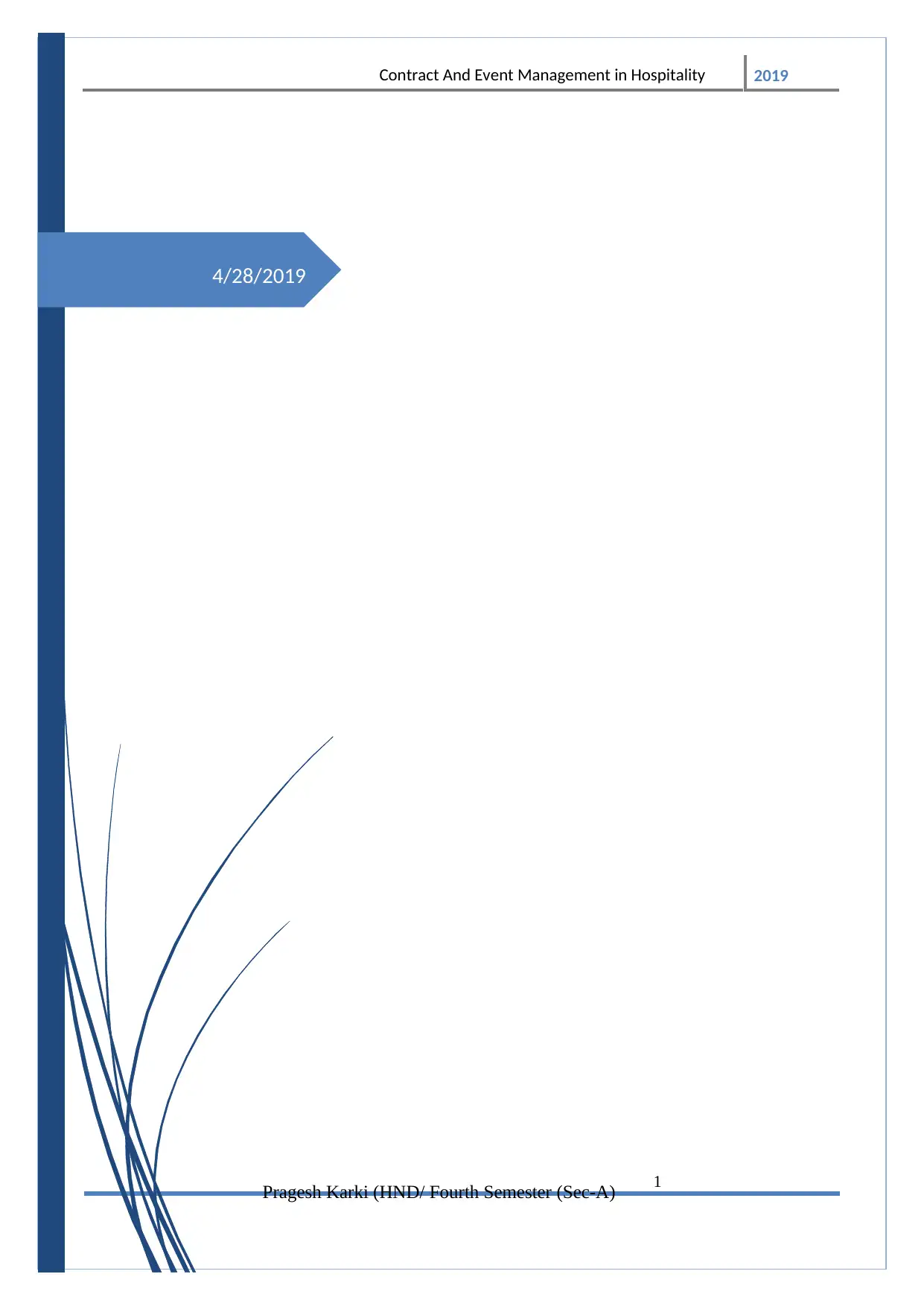
Contract And Event Management in Hospitality 2019
Pragesh Karki (HND/ Fourth Semester (Sec-A) 1
4/28/2019
Pragesh Karki (HND/ Fourth Semester (Sec-A) 1
4/28/2019
Paraphrase This Document
Need a fresh take? Get an instant paraphrase of this document with our AI Paraphraser
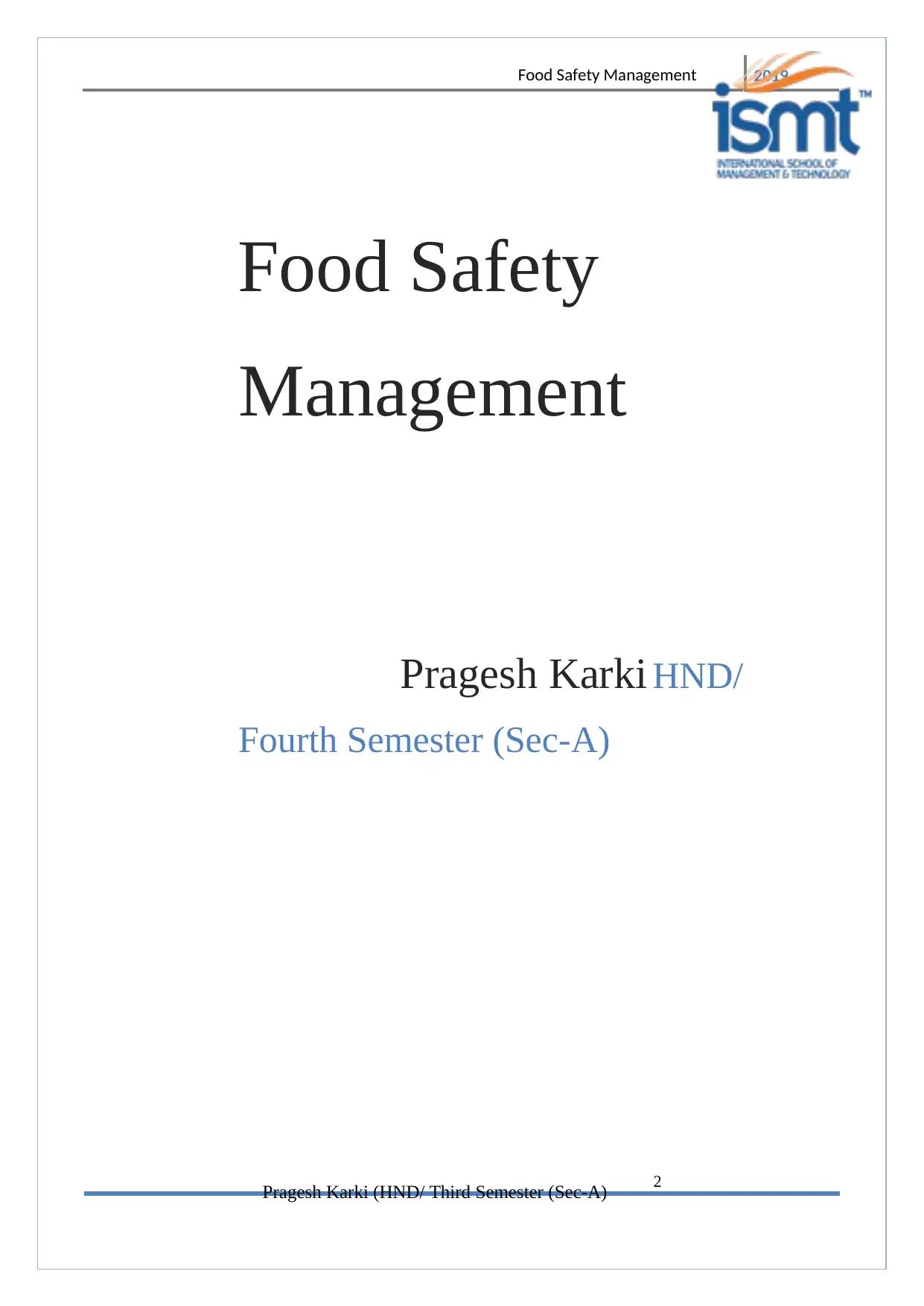
Food Safety Management 2019
Food Safety
Management
Pragesh Karki HND/
Fourth Semester (Sec-A)
Pragesh Karki (HND/ Third Semester (Sec-A) 2
Food Safety
Management
Pragesh Karki HND/
Fourth Semester (Sec-A)
Pragesh Karki (HND/ Third Semester (Sec-A) 2
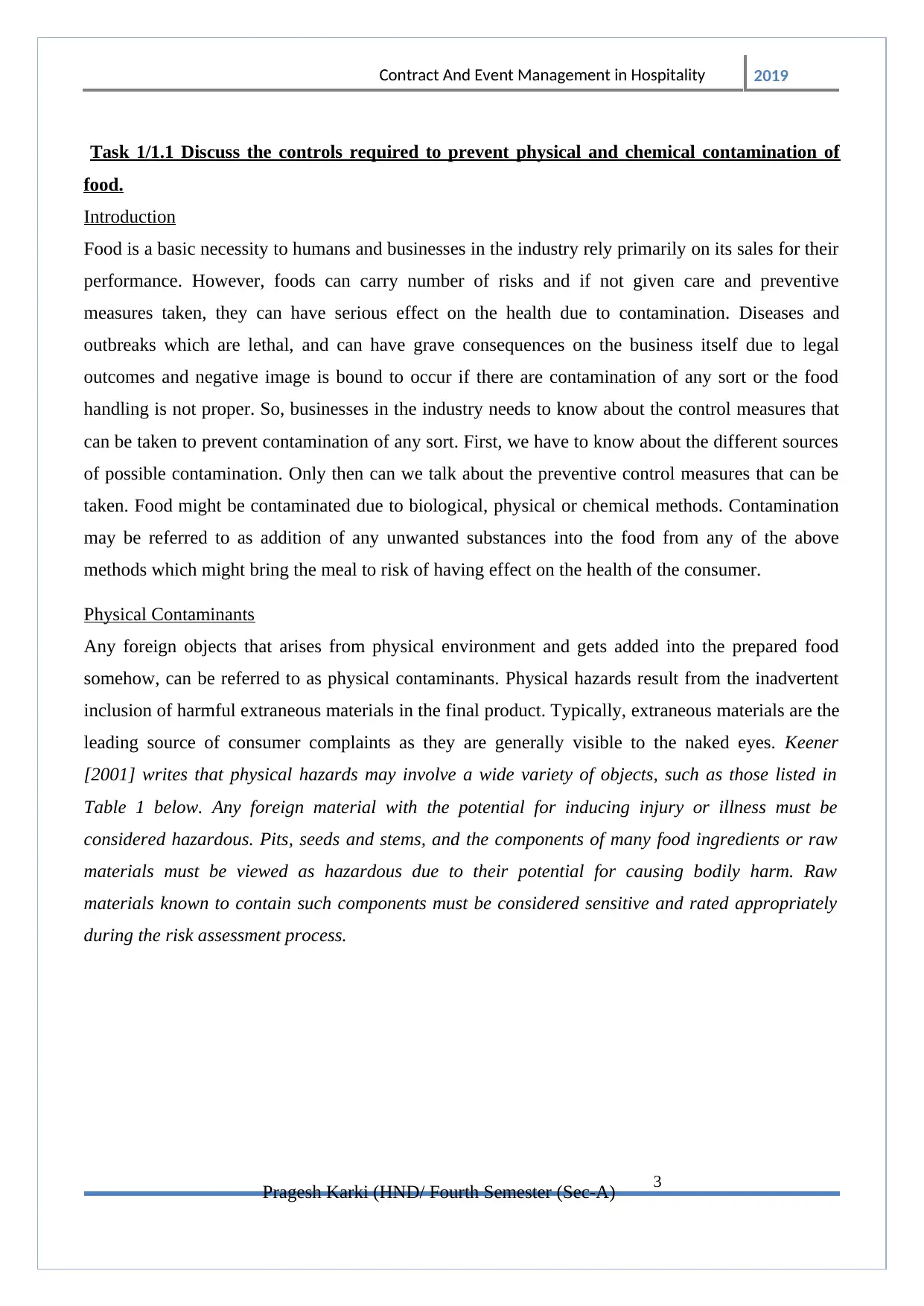
Contract And Event Management in Hospitality 2019
Task 1/1.1 Discuss the controls required to prevent physical and chemical contamination of
food.
Introduction
Food is a basic necessity to humans and businesses in the industry rely primarily on its sales for their
performance. However, foods can carry number of risks and if not given care and preventive
measures taken, they can have serious effect on the health due to contamination. Diseases and
outbreaks which are lethal, and can have grave consequences on the business itself due to legal
outcomes and negative image is bound to occur if there are contamination of any sort or the food
handling is not proper. So, businesses in the industry needs to know about the control measures that
can be taken to prevent contamination of any sort. First, we have to know about the different sources
of possible contamination. Only then can we talk about the preventive control measures that can be
taken. Food might be contaminated due to biological, physical or chemical methods. Contamination
may be referred to as addition of any unwanted substances into the food from any of the above
methods which might bring the meal to risk of having effect on the health of the consumer.
Physical Contaminants
Any foreign objects that arises from physical environment and gets added into the prepared food
somehow, can be referred to as physical contaminants. Physical hazards result from the inadvertent
inclusion of harmful extraneous materials in the final product. Typically, extraneous materials are the
leading source of consumer complaints as they are generally visible to the naked eyes. Keener
[2001] writes that physical hazards may involve a wide variety of objects, such as those listed in
Table 1 below. Any foreign material with the potential for inducing injury or illness must be
considered hazardous. Pits, seeds and stems, and the components of many food ingredients or raw
materials must be viewed as hazardous due to their potential for causing bodily harm. Raw
materials known to contain such components must be considered sensitive and rated appropriately
during the risk assessment process.
Pragesh Karki (HND/ Fourth Semester (Sec-A) 3
Task 1/1.1 Discuss the controls required to prevent physical and chemical contamination of
food.
Introduction
Food is a basic necessity to humans and businesses in the industry rely primarily on its sales for their
performance. However, foods can carry number of risks and if not given care and preventive
measures taken, they can have serious effect on the health due to contamination. Diseases and
outbreaks which are lethal, and can have grave consequences on the business itself due to legal
outcomes and negative image is bound to occur if there are contamination of any sort or the food
handling is not proper. So, businesses in the industry needs to know about the control measures that
can be taken to prevent contamination of any sort. First, we have to know about the different sources
of possible contamination. Only then can we talk about the preventive control measures that can be
taken. Food might be contaminated due to biological, physical or chemical methods. Contamination
may be referred to as addition of any unwanted substances into the food from any of the above
methods which might bring the meal to risk of having effect on the health of the consumer.
Physical Contaminants
Any foreign objects that arises from physical environment and gets added into the prepared food
somehow, can be referred to as physical contaminants. Physical hazards result from the inadvertent
inclusion of harmful extraneous materials in the final product. Typically, extraneous materials are the
leading source of consumer complaints as they are generally visible to the naked eyes. Keener
[2001] writes that physical hazards may involve a wide variety of objects, such as those listed in
Table 1 below. Any foreign material with the potential for inducing injury or illness must be
considered hazardous. Pits, seeds and stems, and the components of many food ingredients or raw
materials must be viewed as hazardous due to their potential for causing bodily harm. Raw
materials known to contain such components must be considered sensitive and rated appropriately
during the risk assessment process.
Pragesh Karki (HND/ Fourth Semester (Sec-A) 3
⊘ This is a preview!⊘
Do you want full access?
Subscribe today to unlock all pages.

Trusted by 1+ million students worldwide
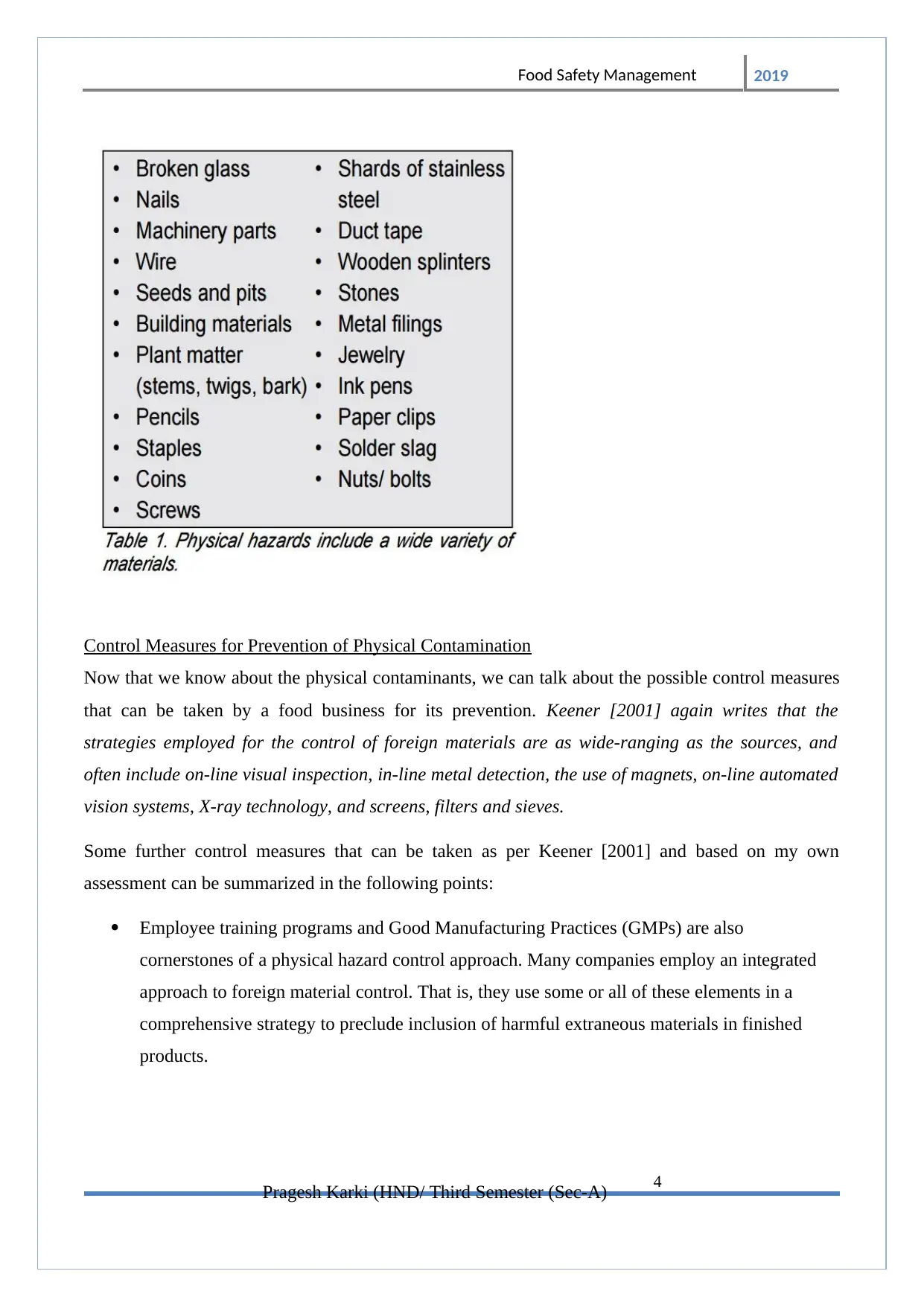
Food Safety Management 2019
Control Measures for Prevention of Physical Contamination
Now that we know about the physical contaminants, we can talk about the possible control measures
that can be taken by a food business for its prevention. Keener [2001] again writes that the
strategies employed for the control of foreign materials are as wide-ranging as the sources, and
often include on-line visual inspection, in-line metal detection, the use of magnets, on-line automated
vision systems, X-ray technology, and screens, filters and sieves.
Some further control measures that can be taken as per Keener [2001] and based on my own
assessment can be summarized in the following points:
Employee training programs and Good Manufacturing Practices (GMPs) are also
cornerstones of a physical hazard control approach. Many companies employ an integrated
approach to foreign material control. That is, they use some or all of these elements in a
comprehensive strategy to preclude inclusion of harmful extraneous materials in finished
products.
Pragesh Karki (HND/ Third Semester (Sec-A) 4
Control Measures for Prevention of Physical Contamination
Now that we know about the physical contaminants, we can talk about the possible control measures
that can be taken by a food business for its prevention. Keener [2001] again writes that the
strategies employed for the control of foreign materials are as wide-ranging as the sources, and
often include on-line visual inspection, in-line metal detection, the use of magnets, on-line automated
vision systems, X-ray technology, and screens, filters and sieves.
Some further control measures that can be taken as per Keener [2001] and based on my own
assessment can be summarized in the following points:
Employee training programs and Good Manufacturing Practices (GMPs) are also
cornerstones of a physical hazard control approach. Many companies employ an integrated
approach to foreign material control. That is, they use some or all of these elements in a
comprehensive strategy to preclude inclusion of harmful extraneous materials in finished
products.
Pragesh Karki (HND/ Third Semester (Sec-A) 4
Paraphrase This Document
Need a fresh take? Get an instant paraphrase of this document with our AI Paraphraser
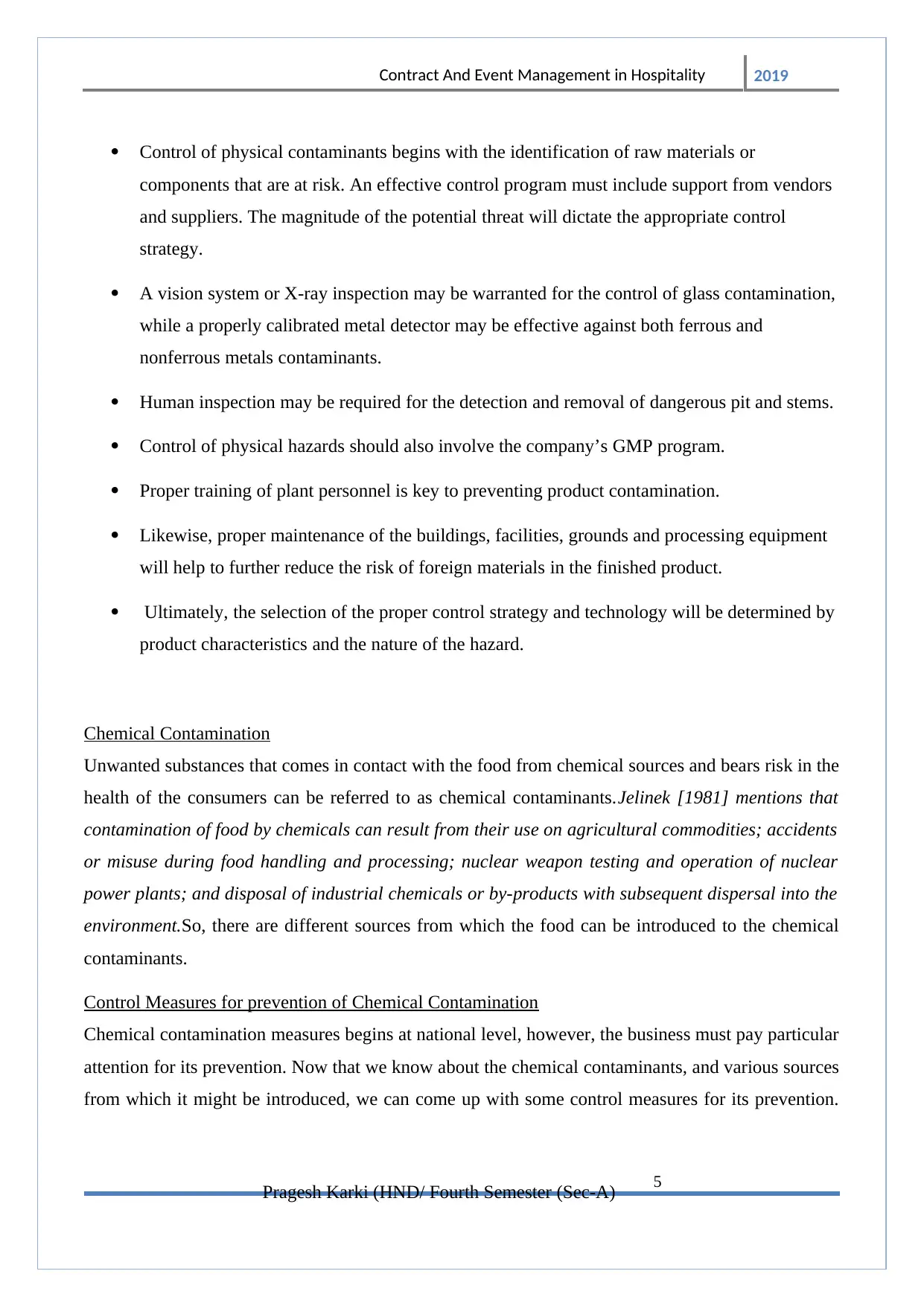
Contract And Event Management in Hospitality 2019
Control of physical contaminants begins with the identification of raw materials or
components that are at risk. An effective control program must include support from vendors
and suppliers. The magnitude of the potential threat will dictate the appropriate control
strategy.
A vision system or X-ray inspection may be warranted for the control of glass contamination,
while a properly calibrated metal detector may be effective against both ferrous and
nonferrous metals contaminants.
Human inspection may be required for the detection and removal of dangerous pit and stems.
Control of physical hazards should also involve the company’s GMP program.
Proper training of plant personnel is key to preventing product contamination.
Likewise, proper maintenance of the buildings, facilities, grounds and processing equipment
will help to further reduce the risk of foreign materials in the finished product.
Ultimately, the selection of the proper control strategy and technology will be determined by
product characteristics and the nature of the hazard.
Chemical Contamination
Unwanted substances that comes in contact with the food from chemical sources and bears risk in the
health of the consumers can be referred to as chemical contaminants.Jelinek [1981] mentions that
contamination of food by chemicals can result from their use on agricultural commodities; accidents
or misuse during food handling and processing; nuclear weapon testing and operation of nuclear
power plants; and disposal of industrial chemicals or by-products with subsequent dispersal into the
environment.So, there are different sources from which the food can be introduced to the chemical
contaminants.
Control Measures for prevention of Chemical Contamination
Chemical contamination measures begins at national level, however, the business must pay particular
attention for its prevention. Now that we know about the chemical contaminants, and various sources
from which it might be introduced, we can come up with some control measures for its prevention.
Pragesh Karki (HND/ Fourth Semester (Sec-A) 5
Control of physical contaminants begins with the identification of raw materials or
components that are at risk. An effective control program must include support from vendors
and suppliers. The magnitude of the potential threat will dictate the appropriate control
strategy.
A vision system or X-ray inspection may be warranted for the control of glass contamination,
while a properly calibrated metal detector may be effective against both ferrous and
nonferrous metals contaminants.
Human inspection may be required for the detection and removal of dangerous pit and stems.
Control of physical hazards should also involve the company’s GMP program.
Proper training of plant personnel is key to preventing product contamination.
Likewise, proper maintenance of the buildings, facilities, grounds and processing equipment
will help to further reduce the risk of foreign materials in the finished product.
Ultimately, the selection of the proper control strategy and technology will be determined by
product characteristics and the nature of the hazard.
Chemical Contamination
Unwanted substances that comes in contact with the food from chemical sources and bears risk in the
health of the consumers can be referred to as chemical contaminants.Jelinek [1981] mentions that
contamination of food by chemicals can result from their use on agricultural commodities; accidents
or misuse during food handling and processing; nuclear weapon testing and operation of nuclear
power plants; and disposal of industrial chemicals or by-products with subsequent dispersal into the
environment.So, there are different sources from which the food can be introduced to the chemical
contaminants.
Control Measures for prevention of Chemical Contamination
Chemical contamination measures begins at national level, however, the business must pay particular
attention for its prevention. Now that we know about the chemical contaminants, and various sources
from which it might be introduced, we can come up with some control measures for its prevention.
Pragesh Karki (HND/ Fourth Semester (Sec-A) 5
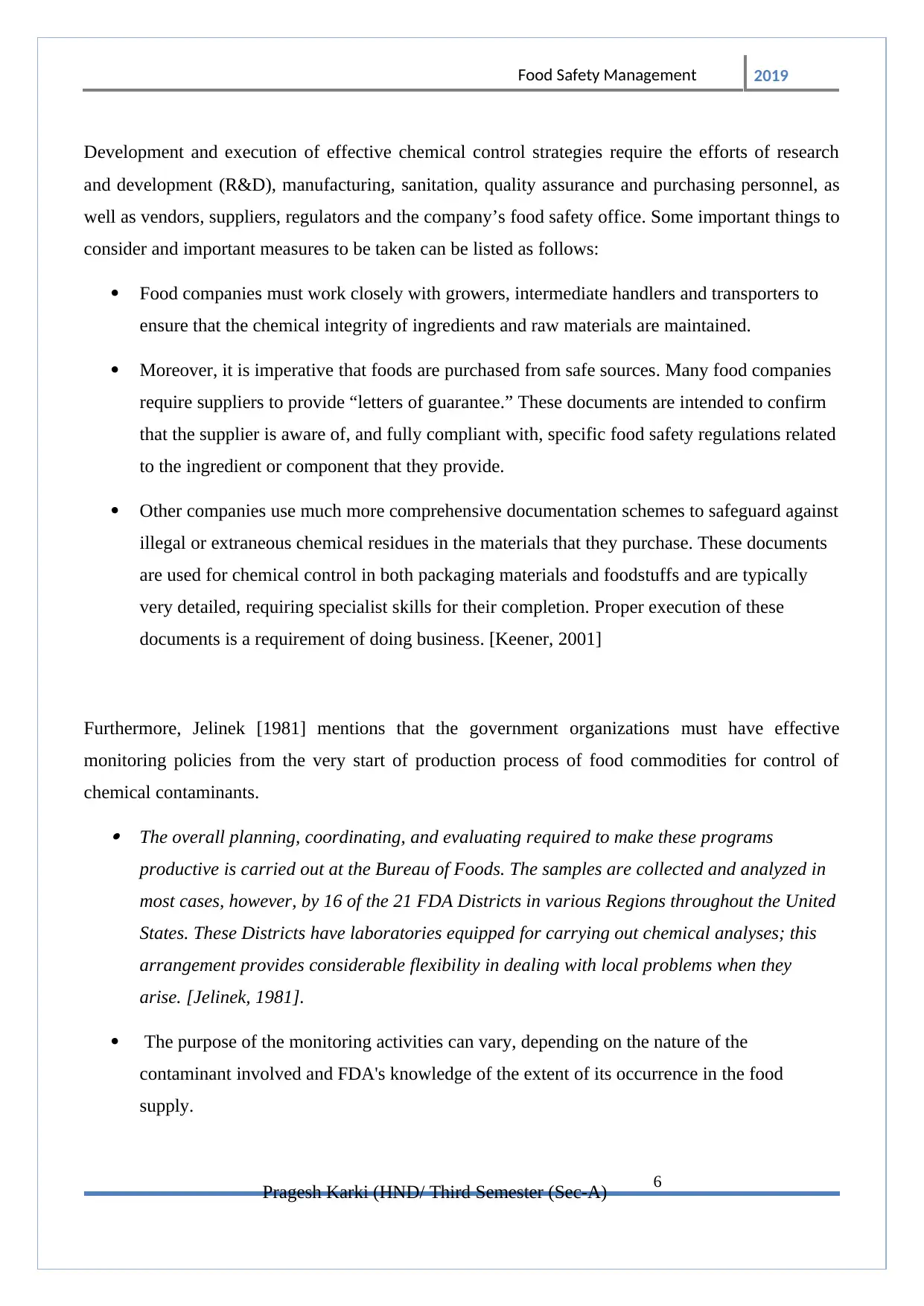
Food Safety Management 2019
Development and execution of effective chemical control strategies require the efforts of research
and development (R&D), manufacturing, sanitation, quality assurance and purchasing personnel, as
well as vendors, suppliers, regulators and the company’s food safety office. Some important things to
consider and important measures to be taken can be listed as follows:
Food companies must work closely with growers, intermediate handlers and transporters to
ensure that the chemical integrity of ingredients and raw materials are maintained.
Moreover, it is imperative that foods are purchased from safe sources. Many food companies
require suppliers to provide “letters of guarantee.” These documents are intended to confirm
that the supplier is aware of, and fully compliant with, specific food safety regulations related
to the ingredient or component that they provide.
Other companies use much more comprehensive documentation schemes to safeguard against
illegal or extraneous chemical residues in the materials that they purchase. These documents
are used for chemical control in both packaging materials and foodstuffs and are typically
very detailed, requiring specialist skills for their completion. Proper execution of these
documents is a requirement of doing business. [Keener, 2001]
Furthermore, Jelinek [1981] mentions that the government organizations must have effective
monitoring policies from the very start of production process of food commodities for control of
chemical contaminants.
The overall planning, coordinating, and evaluating required to make these programs
productive is carried out at the Bureau of Foods. The samples are collected and analyzed in
most cases, however, by 16 of the 21 FDA Districts in various Regions throughout the United
States. These Districts have laboratories equipped for carrying out chemical analyses; this
arrangement provides considerable flexibility in dealing with local problems when they
arise. [Jelinek, 1981].
The purpose of the monitoring activities can vary, depending on the nature of the
contaminant involved and FDA's knowledge of the extent of its occurrence in the food
supply.
Pragesh Karki (HND/ Third Semester (Sec-A) 6
Development and execution of effective chemical control strategies require the efforts of research
and development (R&D), manufacturing, sanitation, quality assurance and purchasing personnel, as
well as vendors, suppliers, regulators and the company’s food safety office. Some important things to
consider and important measures to be taken can be listed as follows:
Food companies must work closely with growers, intermediate handlers and transporters to
ensure that the chemical integrity of ingredients and raw materials are maintained.
Moreover, it is imperative that foods are purchased from safe sources. Many food companies
require suppliers to provide “letters of guarantee.” These documents are intended to confirm
that the supplier is aware of, and fully compliant with, specific food safety regulations related
to the ingredient or component that they provide.
Other companies use much more comprehensive documentation schemes to safeguard against
illegal or extraneous chemical residues in the materials that they purchase. These documents
are used for chemical control in both packaging materials and foodstuffs and are typically
very detailed, requiring specialist skills for their completion. Proper execution of these
documents is a requirement of doing business. [Keener, 2001]
Furthermore, Jelinek [1981] mentions that the government organizations must have effective
monitoring policies from the very start of production process of food commodities for control of
chemical contaminants.
The overall planning, coordinating, and evaluating required to make these programs
productive is carried out at the Bureau of Foods. The samples are collected and analyzed in
most cases, however, by 16 of the 21 FDA Districts in various Regions throughout the United
States. These Districts have laboratories equipped for carrying out chemical analyses; this
arrangement provides considerable flexibility in dealing with local problems when they
arise. [Jelinek, 1981].
The purpose of the monitoring activities can vary, depending on the nature of the
contaminant involved and FDA's knowledge of the extent of its occurrence in the food
supply.
Pragesh Karki (HND/ Third Semester (Sec-A) 6
⊘ This is a preview!⊘
Do you want full access?
Subscribe today to unlock all pages.

Trusted by 1+ million students worldwide
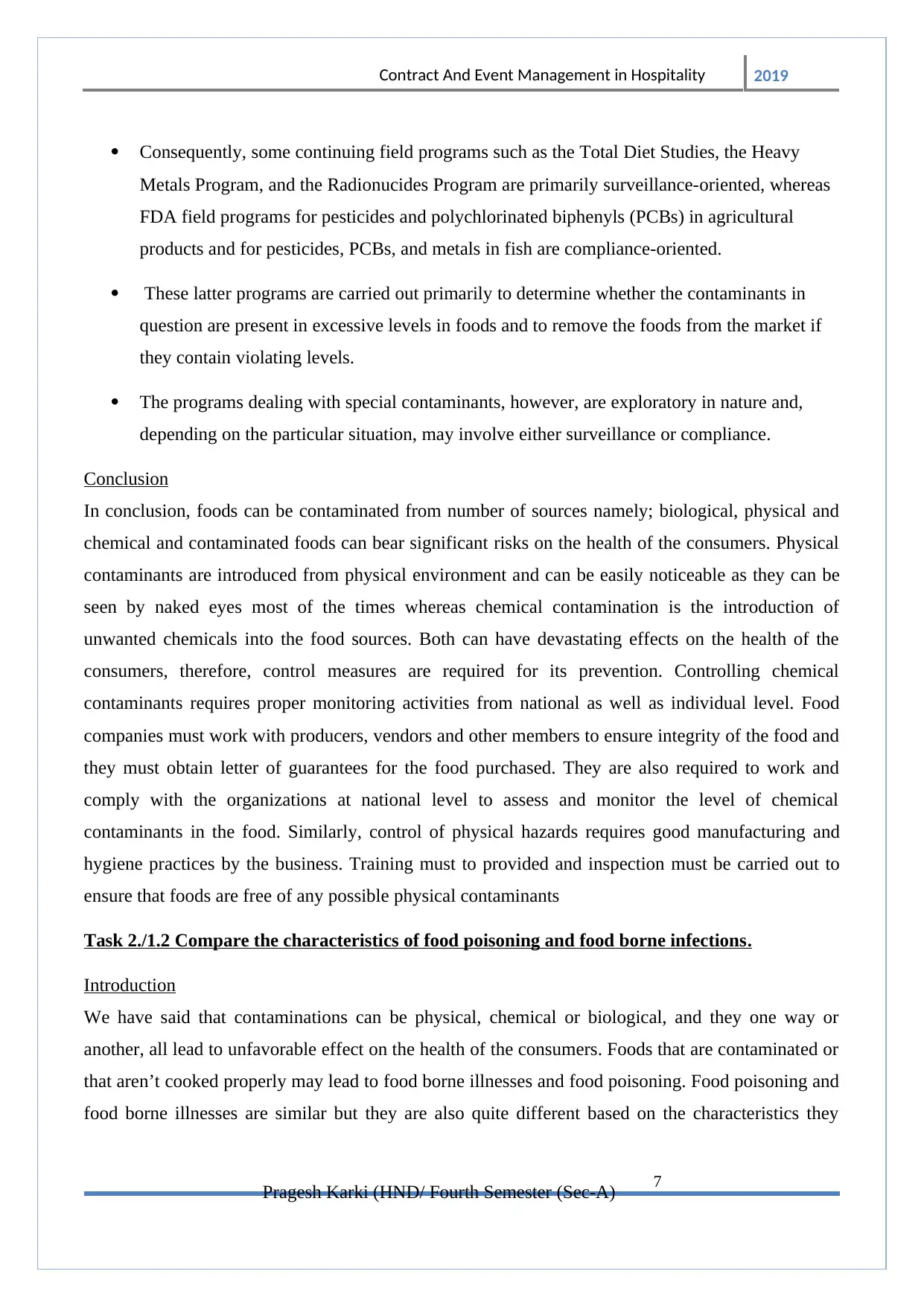
Contract And Event Management in Hospitality 2019
Consequently, some continuing field programs such as the Total Diet Studies, the Heavy
Metals Program, and the Radionucides Program are primarily surveillance-oriented, whereas
FDA field programs for pesticides and polychlorinated biphenyls (PCBs) in agricultural
products and for pesticides, PCBs, and metals in fish are compliance-oriented.
These latter programs are carried out primarily to determine whether the contaminants in
question are present in excessive levels in foods and to remove the foods from the market if
they contain violating levels.
The programs dealing with special contaminants, however, are exploratory in nature and,
depending on the particular situation, may involve either surveillance or compliance.
Conclusion
In conclusion, foods can be contaminated from number of sources namely; biological, physical and
chemical and contaminated foods can bear significant risks on the health of the consumers. Physical
contaminants are introduced from physical environment and can be easily noticeable as they can be
seen by naked eyes most of the times whereas chemical contamination is the introduction of
unwanted chemicals into the food sources. Both can have devastating effects on the health of the
consumers, therefore, control measures are required for its prevention. Controlling chemical
contaminants requires proper monitoring activities from national as well as individual level. Food
companies must work with producers, vendors and other members to ensure integrity of the food and
they must obtain letter of guarantees for the food purchased. They are also required to work and
comply with the organizations at national level to assess and monitor the level of chemical
contaminants in the food. Similarly, control of physical hazards requires good manufacturing and
hygiene practices by the business. Training must to provided and inspection must be carried out to
ensure that foods are free of any possible physical contaminants
Task 2./1.2 Compare the characteristics of food poisoning and food borne infections.
Introduction
We have said that contaminations can be physical, chemical or biological, and they one way or
another, all lead to unfavorable effect on the health of the consumers. Foods that are contaminated or
that aren’t cooked properly may lead to food borne illnesses and food poisoning. Food poisoning and
food borne illnesses are similar but they are also quite different based on the characteristics they
Pragesh Karki (HND/ Fourth Semester (Sec-A) 7
Consequently, some continuing field programs such as the Total Diet Studies, the Heavy
Metals Program, and the Radionucides Program are primarily surveillance-oriented, whereas
FDA field programs for pesticides and polychlorinated biphenyls (PCBs) in agricultural
products and for pesticides, PCBs, and metals in fish are compliance-oriented.
These latter programs are carried out primarily to determine whether the contaminants in
question are present in excessive levels in foods and to remove the foods from the market if
they contain violating levels.
The programs dealing with special contaminants, however, are exploratory in nature and,
depending on the particular situation, may involve either surveillance or compliance.
Conclusion
In conclusion, foods can be contaminated from number of sources namely; biological, physical and
chemical and contaminated foods can bear significant risks on the health of the consumers. Physical
contaminants are introduced from physical environment and can be easily noticeable as they can be
seen by naked eyes most of the times whereas chemical contamination is the introduction of
unwanted chemicals into the food sources. Both can have devastating effects on the health of the
consumers, therefore, control measures are required for its prevention. Controlling chemical
contaminants requires proper monitoring activities from national as well as individual level. Food
companies must work with producers, vendors and other members to ensure integrity of the food and
they must obtain letter of guarantees for the food purchased. They are also required to work and
comply with the organizations at national level to assess and monitor the level of chemical
contaminants in the food. Similarly, control of physical hazards requires good manufacturing and
hygiene practices by the business. Training must to provided and inspection must be carried out to
ensure that foods are free of any possible physical contaminants
Task 2./1.2 Compare the characteristics of food poisoning and food borne infections.
Introduction
We have said that contaminations can be physical, chemical or biological, and they one way or
another, all lead to unfavorable effect on the health of the consumers. Foods that are contaminated or
that aren’t cooked properly may lead to food borne illnesses and food poisoning. Food poisoning and
food borne illnesses are similar but they are also quite different based on the characteristics they
Pragesh Karki (HND/ Fourth Semester (Sec-A) 7
Paraphrase This Document
Need a fresh take? Get an instant paraphrase of this document with our AI Paraphraser
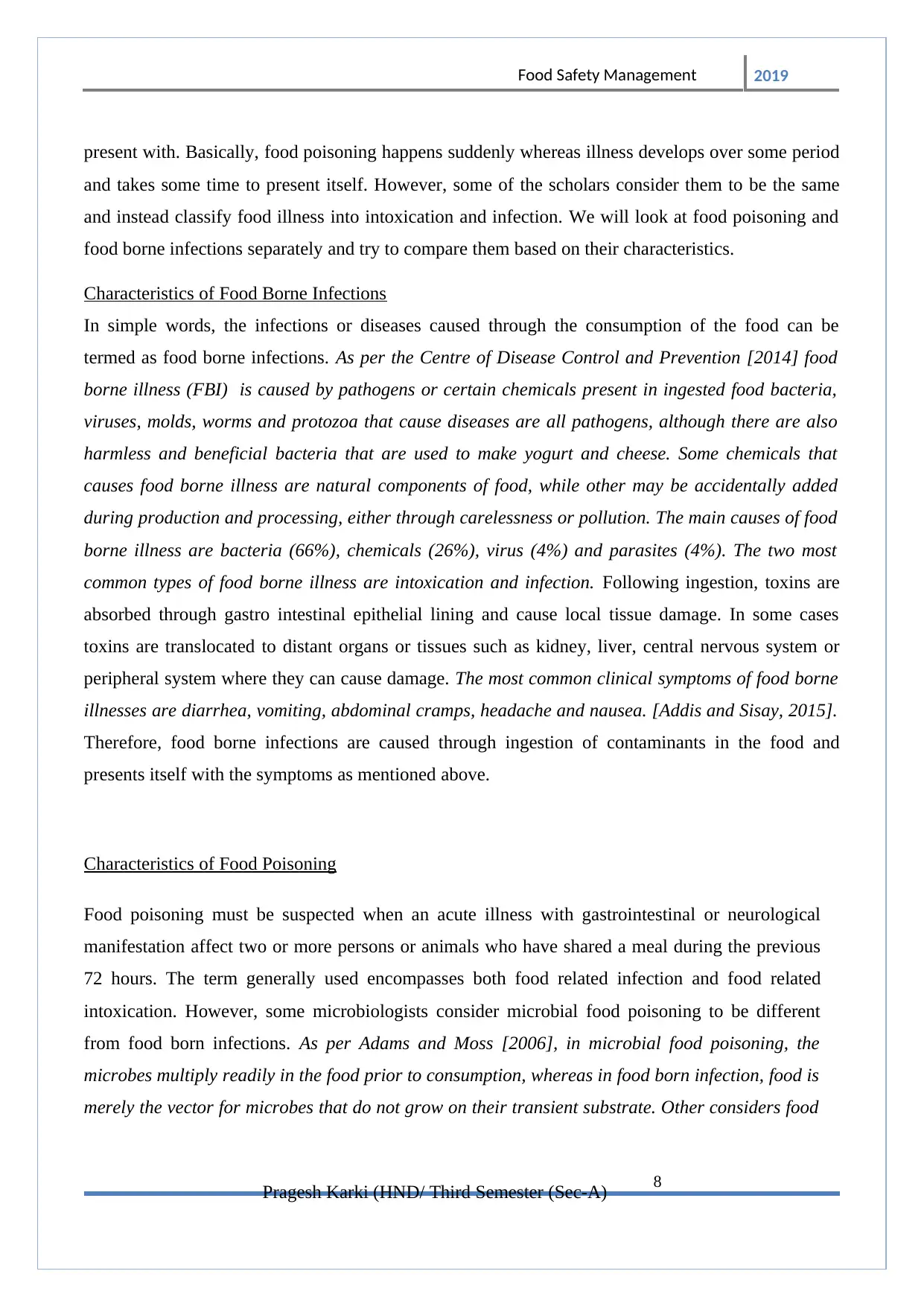
Food Safety Management 2019
present with. Basically, food poisoning happens suddenly whereas illness develops over some period
and takes some time to present itself. However, some of the scholars consider them to be the same
and instead classify food illness into intoxication and infection. We will look at food poisoning and
food borne infections separately and try to compare them based on their characteristics.
Characteristics of Food Borne Infections
In simple words, the infections or diseases caused through the consumption of the food can be
termed as food borne infections. As per the Centre of Disease Control and Prevention [2014] food
borne illness (FBI) is caused by pathogens or certain chemicals present in ingested food bacteria,
viruses, molds, worms and protozoa that cause diseases are all pathogens, although there are also
harmless and beneficial bacteria that are used to make yogurt and cheese. Some chemicals that
causes food borne illness are natural components of food, while other may be accidentally added
during production and processing, either through carelessness or pollution. The main causes of food
borne illness are bacteria (66%), chemicals (26%), virus (4%) and parasites (4%). The two most
common types of food borne illness are intoxication and infection. Following ingestion, toxins are
absorbed through gastro intestinal epithelial lining and cause local tissue damage. In some cases
toxins are translocated to distant organs or tissues such as kidney, liver, central nervous system or
peripheral system where they can cause damage. The most common clinical symptoms of food borne
illnesses are diarrhea, vomiting, abdominal cramps, headache and nausea. [Addis and Sisay, 2015].
Therefore, food borne infections are caused through ingestion of contaminants in the food and
presents itself with the symptoms as mentioned above.
Characteristics of Food Poisoning
Food poisoning must be suspected when an acute illness with gastrointestinal or neurological
manifestation affect two or more persons or animals who have shared a meal during the previous
72 hours. The term generally used encompasses both food related infection and food related
intoxication. However, some microbiologists consider microbial food poisoning to be different
from food born infections. As per Adams and Moss [2006], in microbial food poisoning, the
microbes multiply readily in the food prior to consumption, whereas in food born infection, food is
merely the vector for microbes that do not grow on their transient substrate. Other considers food
Pragesh Karki (HND/ Third Semester (Sec-A) 8
present with. Basically, food poisoning happens suddenly whereas illness develops over some period
and takes some time to present itself. However, some of the scholars consider them to be the same
and instead classify food illness into intoxication and infection. We will look at food poisoning and
food borne infections separately and try to compare them based on their characteristics.
Characteristics of Food Borne Infections
In simple words, the infections or diseases caused through the consumption of the food can be
termed as food borne infections. As per the Centre of Disease Control and Prevention [2014] food
borne illness (FBI) is caused by pathogens or certain chemicals present in ingested food bacteria,
viruses, molds, worms and protozoa that cause diseases are all pathogens, although there are also
harmless and beneficial bacteria that are used to make yogurt and cheese. Some chemicals that
causes food borne illness are natural components of food, while other may be accidentally added
during production and processing, either through carelessness or pollution. The main causes of food
borne illness are bacteria (66%), chemicals (26%), virus (4%) and parasites (4%). The two most
common types of food borne illness are intoxication and infection. Following ingestion, toxins are
absorbed through gastro intestinal epithelial lining and cause local tissue damage. In some cases
toxins are translocated to distant organs or tissues such as kidney, liver, central nervous system or
peripheral system where they can cause damage. The most common clinical symptoms of food borne
illnesses are diarrhea, vomiting, abdominal cramps, headache and nausea. [Addis and Sisay, 2015].
Therefore, food borne infections are caused through ingestion of contaminants in the food and
presents itself with the symptoms as mentioned above.
Characteristics of Food Poisoning
Food poisoning must be suspected when an acute illness with gastrointestinal or neurological
manifestation affect two or more persons or animals who have shared a meal during the previous
72 hours. The term generally used encompasses both food related infection and food related
intoxication. However, some microbiologists consider microbial food poisoning to be different
from food born infections. As per Adams and Moss [2006], in microbial food poisoning, the
microbes multiply readily in the food prior to consumption, whereas in food born infection, food is
merely the vector for microbes that do not grow on their transient substrate. Other considers food
Pragesh Karki (HND/ Third Semester (Sec-A) 8
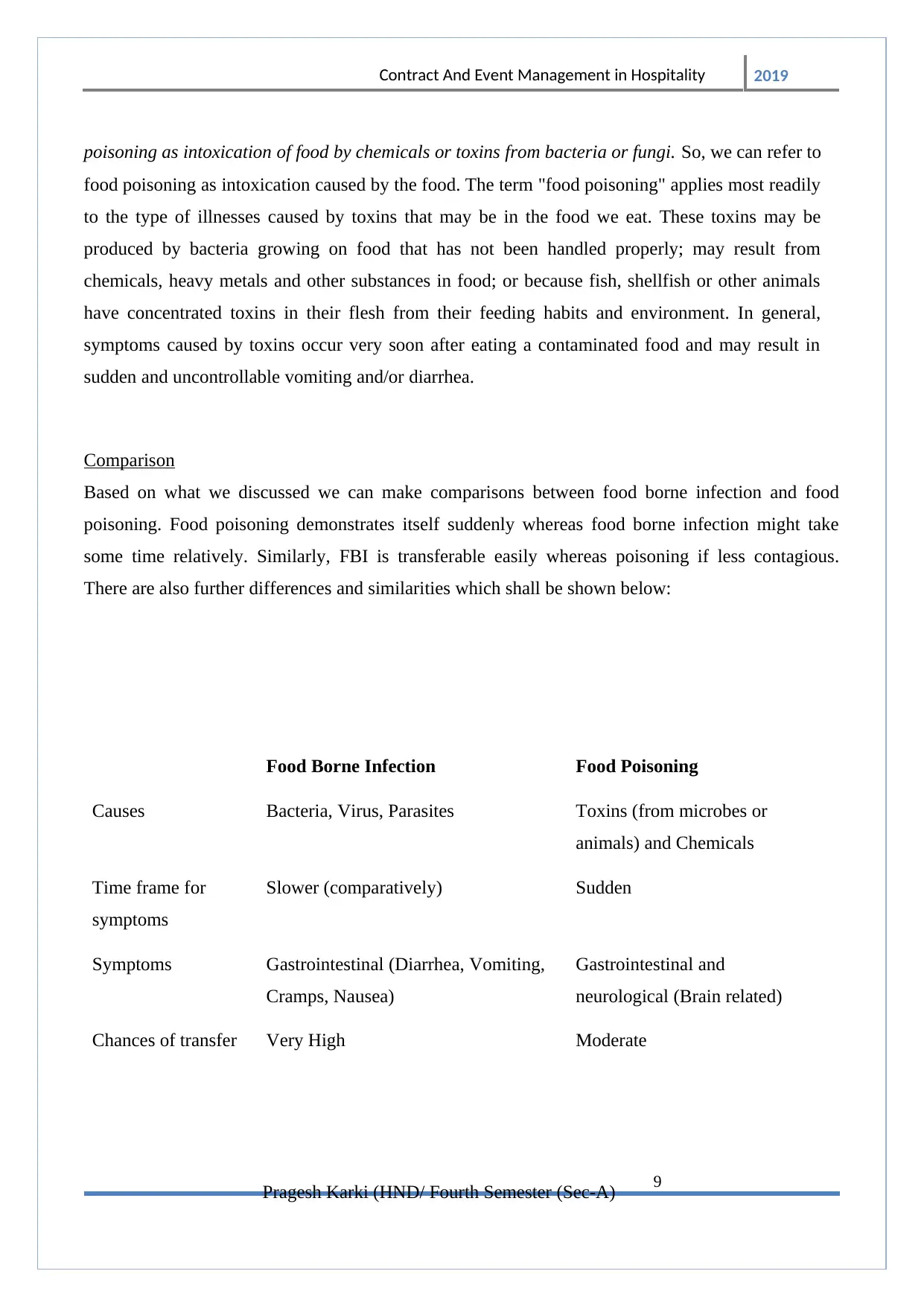
Contract And Event Management in Hospitality 2019
poisoning as intoxication of food by chemicals or toxins from bacteria or fungi. So, we can refer to
food poisoning as intoxication caused by the food. The term "food poisoning" applies most readily
to the type of illnesses caused by toxins that may be in the food we eat. These toxins may be
produced by bacteria growing on food that has not been handled properly; may result from
chemicals, heavy metals and other substances in food; or because fish, shellfish or other animals
have concentrated toxins in their flesh from their feeding habits and environment. In general,
symptoms caused by toxins occur very soon after eating a contaminated food and may result in
sudden and uncontrollable vomiting and/or diarrhea.
Comparison
Based on what we discussed we can make comparisons between food borne infection and food
poisoning. Food poisoning demonstrates itself suddenly whereas food borne infection might take
some time relatively. Similarly, FBI is transferable easily whereas poisoning if less contagious.
There are also further differences and similarities which shall be shown below:
Food Borne Infection Food Poisoning
Causes Bacteria, Virus, Parasites Toxins (from microbes or
animals) and Chemicals
Time frame for
symptoms
Slower (comparatively) Sudden
Symptoms Gastrointestinal (Diarrhea, Vomiting,
Cramps, Nausea)
Gastrointestinal and
neurological (Brain related)
Chances of transfer Very High Moderate
Pragesh Karki (HND/ Fourth Semester (Sec-A) 9
poisoning as intoxication of food by chemicals or toxins from bacteria or fungi. So, we can refer to
food poisoning as intoxication caused by the food. The term "food poisoning" applies most readily
to the type of illnesses caused by toxins that may be in the food we eat. These toxins may be
produced by bacteria growing on food that has not been handled properly; may result from
chemicals, heavy metals and other substances in food; or because fish, shellfish or other animals
have concentrated toxins in their flesh from their feeding habits and environment. In general,
symptoms caused by toxins occur very soon after eating a contaminated food and may result in
sudden and uncontrollable vomiting and/or diarrhea.
Comparison
Based on what we discussed we can make comparisons between food borne infection and food
poisoning. Food poisoning demonstrates itself suddenly whereas food borne infection might take
some time relatively. Similarly, FBI is transferable easily whereas poisoning if less contagious.
There are also further differences and similarities which shall be shown below:
Food Borne Infection Food Poisoning
Causes Bacteria, Virus, Parasites Toxins (from microbes or
animals) and Chemicals
Time frame for
symptoms
Slower (comparatively) Sudden
Symptoms Gastrointestinal (Diarrhea, Vomiting,
Cramps, Nausea)
Gastrointestinal and
neurological (Brain related)
Chances of transfer Very High Moderate
Pragesh Karki (HND/ Fourth Semester (Sec-A) 9
⊘ This is a preview!⊘
Do you want full access?
Subscribe today to unlock all pages.

Trusted by 1+ million students worldwide
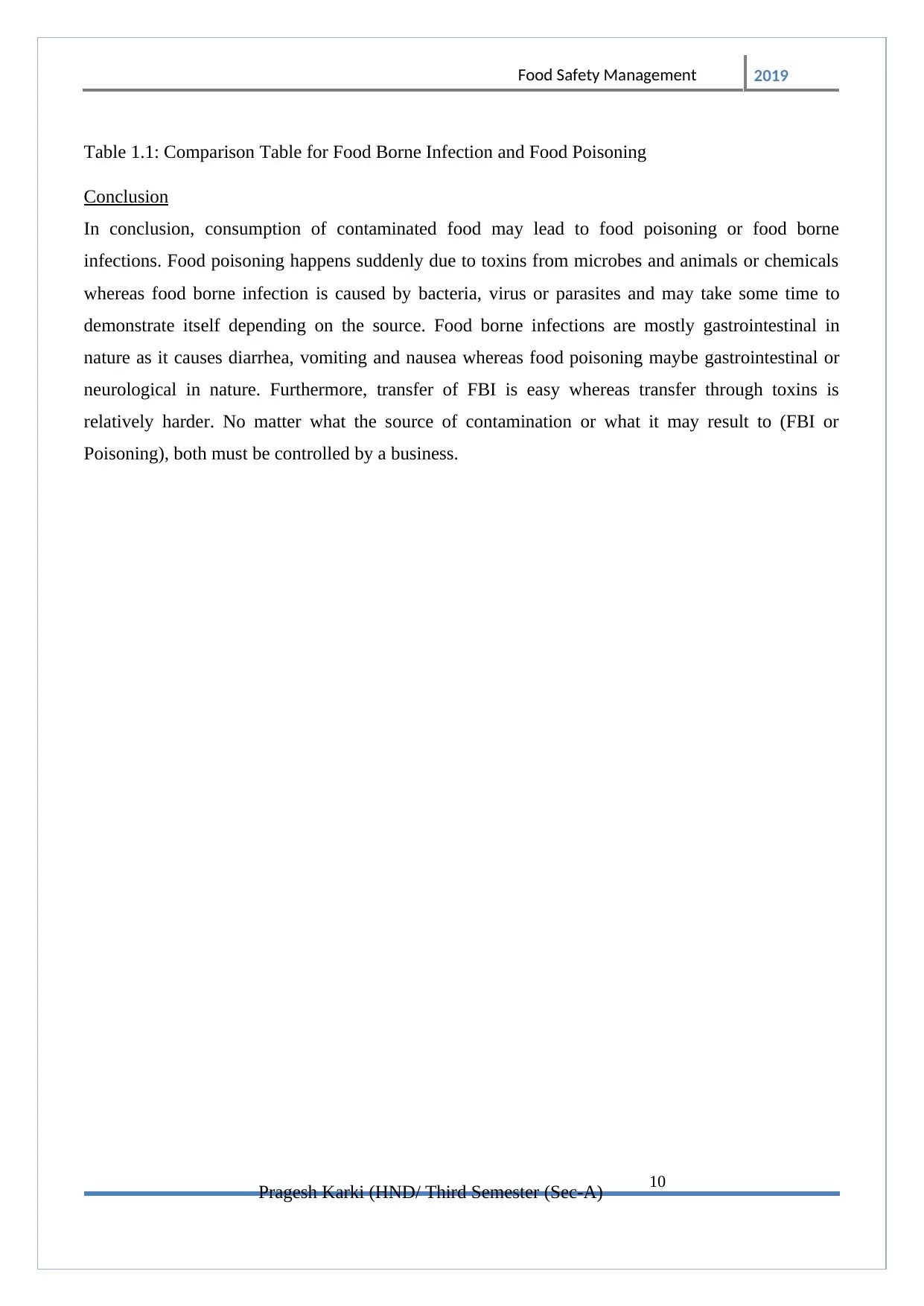
Food Safety Management 2019
Table 1.1: Comparison Table for Food Borne Infection and Food Poisoning
Conclusion
In conclusion, consumption of contaminated food may lead to food poisoning or food borne
infections. Food poisoning happens suddenly due to toxins from microbes and animals or chemicals
whereas food borne infection is caused by bacteria, virus or parasites and may take some time to
demonstrate itself depending on the source. Food borne infections are mostly gastrointestinal in
nature as it causes diarrhea, vomiting and nausea whereas food poisoning maybe gastrointestinal or
neurological in nature. Furthermore, transfer of FBI is easy whereas transfer through toxins is
relatively harder. No matter what the source of contamination or what it may result to (FBI or
Poisoning), both must be controlled by a business.
Pragesh Karki (HND/ Third Semester (Sec-A) 10
Table 1.1: Comparison Table for Food Borne Infection and Food Poisoning
Conclusion
In conclusion, consumption of contaminated food may lead to food poisoning or food borne
infections. Food poisoning happens suddenly due to toxins from microbes and animals or chemicals
whereas food borne infection is caused by bacteria, virus or parasites and may take some time to
demonstrate itself depending on the source. Food borne infections are mostly gastrointestinal in
nature as it causes diarrhea, vomiting and nausea whereas food poisoning maybe gastrointestinal or
neurological in nature. Furthermore, transfer of FBI is easy whereas transfer through toxins is
relatively harder. No matter what the source of contamination or what it may result to (FBI or
Poisoning), both must be controlled by a business.
Pragesh Karki (HND/ Third Semester (Sec-A) 10
Paraphrase This Document
Need a fresh take? Get an instant paraphrase of this document with our AI Paraphraser
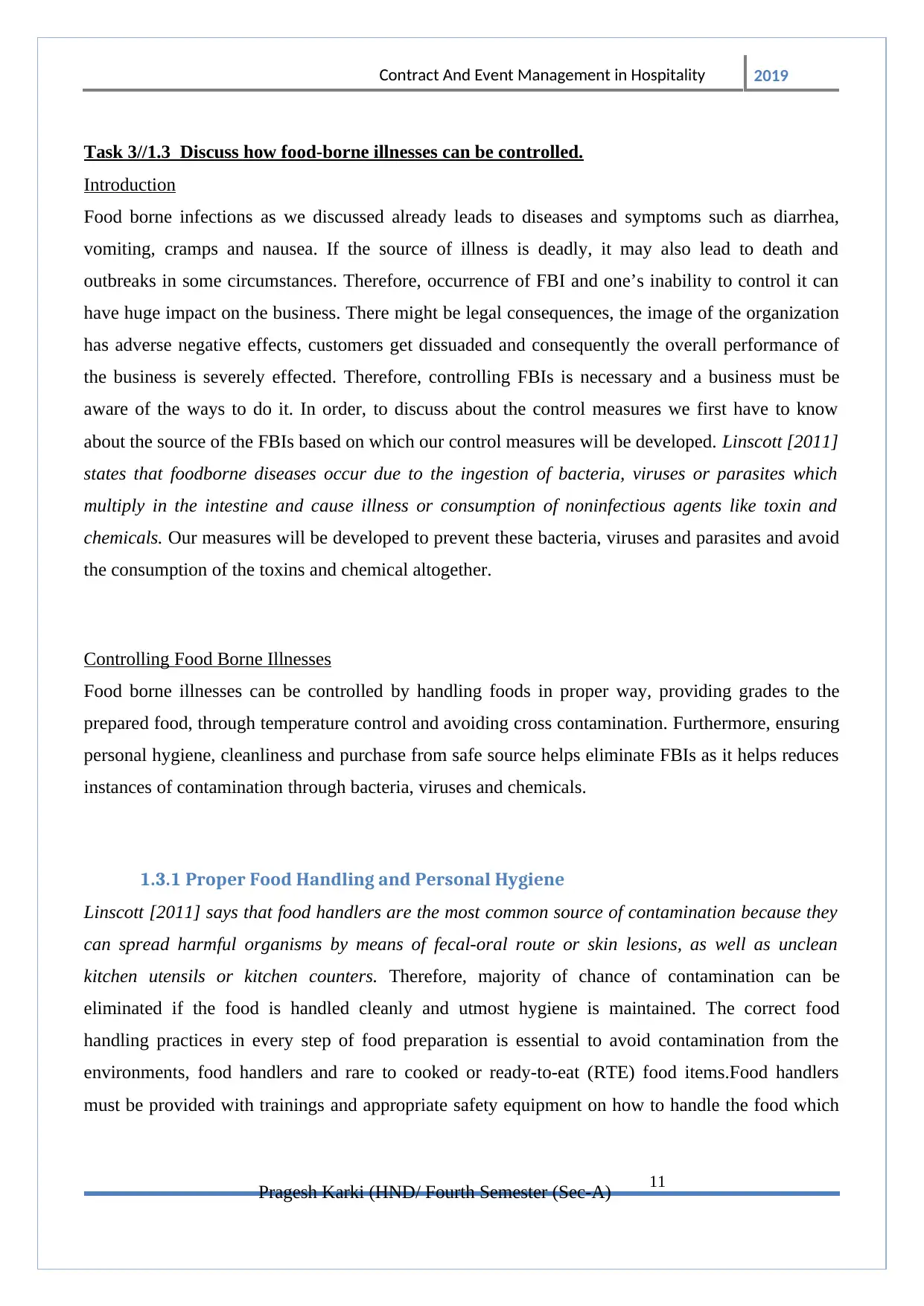
Contract And Event Management in Hospitality 2019
Task 3//1.3 Discuss how food-borne illnesses can be controlled.
Introduction
Food borne infections as we discussed already leads to diseases and symptoms such as diarrhea,
vomiting, cramps and nausea. If the source of illness is deadly, it may also lead to death and
outbreaks in some circumstances. Therefore, occurrence of FBI and one’s inability to control it can
have huge impact on the business. There might be legal consequences, the image of the organization
has adverse negative effects, customers get dissuaded and consequently the overall performance of
the business is severely effected. Therefore, controlling FBIs is necessary and a business must be
aware of the ways to do it. In order, to discuss about the control measures we first have to know
about the source of the FBIs based on which our control measures will be developed. Linscott [2011]
states that foodborne diseases occur due to the ingestion of bacteria, viruses or parasites which
multiply in the intestine and cause illness or consumption of noninfectious agents like toxin and
chemicals. Our measures will be developed to prevent these bacteria, viruses and parasites and avoid
the consumption of the toxins and chemical altogether.
Controlling Food Borne Illnesses
Food borne illnesses can be controlled by handling foods in proper way, providing grades to the
prepared food, through temperature control and avoiding cross contamination. Furthermore, ensuring
personal hygiene, cleanliness and purchase from safe source helps eliminate FBIs as it helps reduces
instances of contamination through bacteria, viruses and chemicals.
1.3.1 Proper Food Handling and Personal Hygiene
Linscott [2011] says that food handlers are the most common source of contamination because they
can spread harmful organisms by means of fecal-oral route or skin lesions, as well as unclean
kitchen utensils or kitchen counters. Therefore, majority of chance of contamination can be
eliminated if the food is handled cleanly and utmost hygiene is maintained. The correct food
handling practices in every step of food preparation is essential to avoid contamination from the
environments, food handlers and rare to cooked or ready-to-eat (RTE) food items.Food handlers
must be provided with trainings and appropriate safety equipment on how to handle the food which
Pragesh Karki (HND/ Fourth Semester (Sec-A) 11
Task 3//1.3 Discuss how food-borne illnesses can be controlled.
Introduction
Food borne infections as we discussed already leads to diseases and symptoms such as diarrhea,
vomiting, cramps and nausea. If the source of illness is deadly, it may also lead to death and
outbreaks in some circumstances. Therefore, occurrence of FBI and one’s inability to control it can
have huge impact on the business. There might be legal consequences, the image of the organization
has adverse negative effects, customers get dissuaded and consequently the overall performance of
the business is severely effected. Therefore, controlling FBIs is necessary and a business must be
aware of the ways to do it. In order, to discuss about the control measures we first have to know
about the source of the FBIs based on which our control measures will be developed. Linscott [2011]
states that foodborne diseases occur due to the ingestion of bacteria, viruses or parasites which
multiply in the intestine and cause illness or consumption of noninfectious agents like toxin and
chemicals. Our measures will be developed to prevent these bacteria, viruses and parasites and avoid
the consumption of the toxins and chemical altogether.
Controlling Food Borne Illnesses
Food borne illnesses can be controlled by handling foods in proper way, providing grades to the
prepared food, through temperature control and avoiding cross contamination. Furthermore, ensuring
personal hygiene, cleanliness and purchase from safe source helps eliminate FBIs as it helps reduces
instances of contamination through bacteria, viruses and chemicals.
1.3.1 Proper Food Handling and Personal Hygiene
Linscott [2011] says that food handlers are the most common source of contamination because they
can spread harmful organisms by means of fecal-oral route or skin lesions, as well as unclean
kitchen utensils or kitchen counters. Therefore, majority of chance of contamination can be
eliminated if the food is handled cleanly and utmost hygiene is maintained. The correct food
handling practices in every step of food preparation is essential to avoid contamination from the
environments, food handlers and rare to cooked or ready-to-eat (RTE) food items.Food handlers
must be provided with trainings and appropriate safety equipment on how to handle the food which
Pragesh Karki (HND/ Fourth Semester (Sec-A) 11
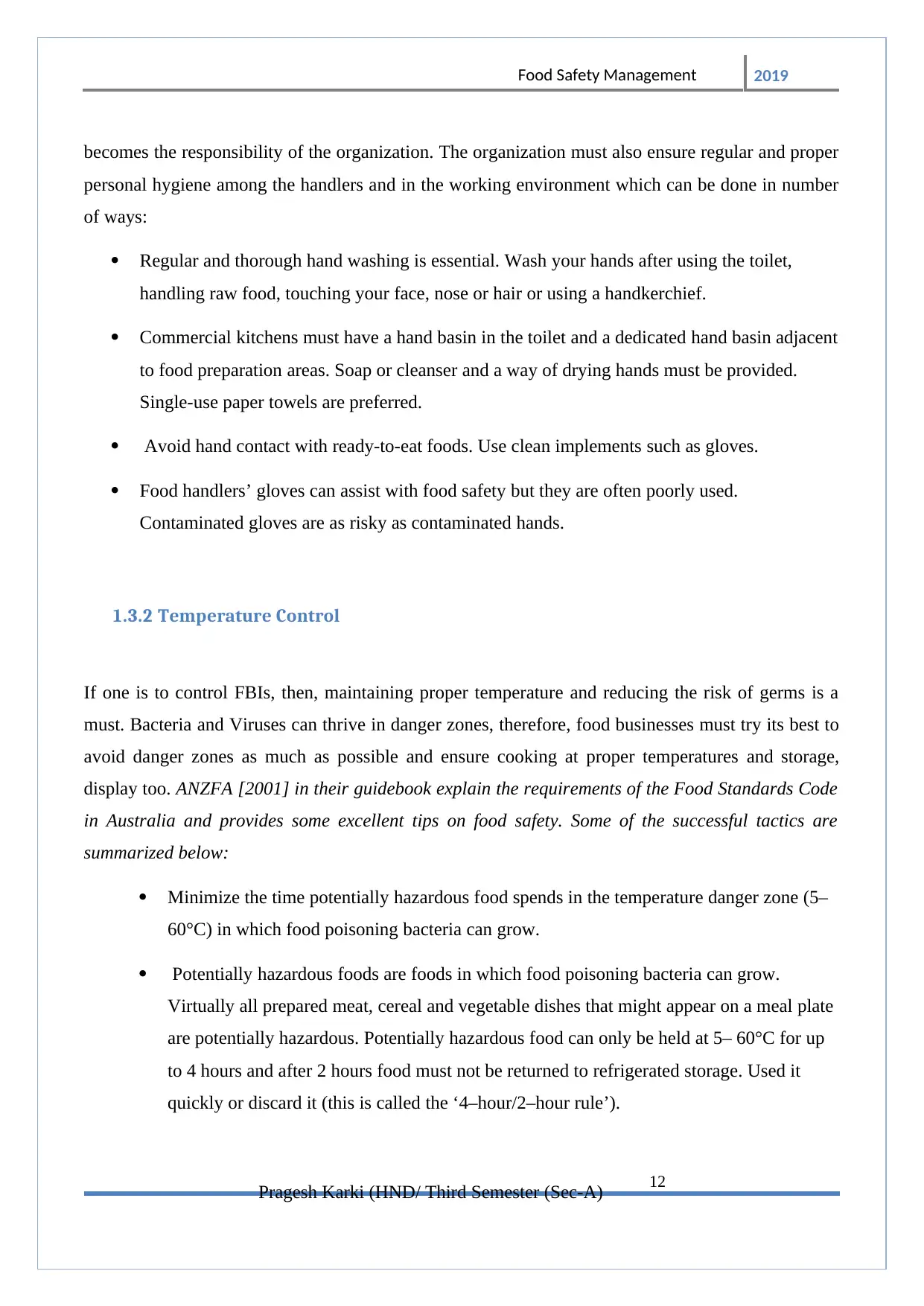
Food Safety Management 2019
becomes the responsibility of the organization. The organization must also ensure regular and proper
personal hygiene among the handlers and in the working environment which can be done in number
of ways:
Regular and thorough hand washing is essential. Wash your hands after using the toilet,
handling raw food, touching your face, nose or hair or using a handkerchief.
Commercial kitchens must have a hand basin in the toilet and a dedicated hand basin adjacent
to food preparation areas. Soap or cleanser and a way of drying hands must be provided.
Single-use paper towels are preferred.
Avoid hand contact with ready-to-eat foods. Use clean implements such as gloves.
Food handlers’ gloves can assist with food safety but they are often poorly used.
Contaminated gloves are as risky as contaminated hands.
1.3.2 Temperature Control
If one is to control FBIs, then, maintaining proper temperature and reducing the risk of germs is a
must. Bacteria and Viruses can thrive in danger zones, therefore, food businesses must try its best to
avoid danger zones as much as possible and ensure cooking at proper temperatures and storage,
display too. ANZFA [2001] in their guidebook explain the requirements of the Food Standards Code
in Australia and provides some excellent tips on food safety. Some of the successful tactics are
summarized below:
Minimize the time potentially hazardous food spends in the temperature danger zone (5–
60°C) in which food poisoning bacteria can grow.
Potentially hazardous foods are foods in which food poisoning bacteria can grow.
Virtually all prepared meat, cereal and vegetable dishes that might appear on a meal plate
are potentially hazardous. Potentially hazardous food can only be held at 5– 60°C for up
to 4 hours and after 2 hours food must not be returned to refrigerated storage. Used it
quickly or discard it (this is called the ‘4–hour/2–hour rule’).
Pragesh Karki (HND/ Third Semester (Sec-A) 12
becomes the responsibility of the organization. The organization must also ensure regular and proper
personal hygiene among the handlers and in the working environment which can be done in number
of ways:
Regular and thorough hand washing is essential. Wash your hands after using the toilet,
handling raw food, touching your face, nose or hair or using a handkerchief.
Commercial kitchens must have a hand basin in the toilet and a dedicated hand basin adjacent
to food preparation areas. Soap or cleanser and a way of drying hands must be provided.
Single-use paper towels are preferred.
Avoid hand contact with ready-to-eat foods. Use clean implements such as gloves.
Food handlers’ gloves can assist with food safety but they are often poorly used.
Contaminated gloves are as risky as contaminated hands.
1.3.2 Temperature Control
If one is to control FBIs, then, maintaining proper temperature and reducing the risk of germs is a
must. Bacteria and Viruses can thrive in danger zones, therefore, food businesses must try its best to
avoid danger zones as much as possible and ensure cooking at proper temperatures and storage,
display too. ANZFA [2001] in their guidebook explain the requirements of the Food Standards Code
in Australia and provides some excellent tips on food safety. Some of the successful tactics are
summarized below:
Minimize the time potentially hazardous food spends in the temperature danger zone (5–
60°C) in which food poisoning bacteria can grow.
Potentially hazardous foods are foods in which food poisoning bacteria can grow.
Virtually all prepared meat, cereal and vegetable dishes that might appear on a meal plate
are potentially hazardous. Potentially hazardous food can only be held at 5– 60°C for up
to 4 hours and after 2 hours food must not be returned to refrigerated storage. Used it
quickly or discard it (this is called the ‘4–hour/2–hour rule’).
Pragesh Karki (HND/ Third Semester (Sec-A) 12
⊘ This is a preview!⊘
Do you want full access?
Subscribe today to unlock all pages.

Trusted by 1+ million students worldwide
1 out of 56
Related Documents
Your All-in-One AI-Powered Toolkit for Academic Success.
+13062052269
info@desklib.com
Available 24*7 on WhatsApp / Email
![[object Object]](/_next/static/media/star-bottom.7253800d.svg)
Unlock your academic potential
Copyright © 2020–2025 A2Z Services. All Rights Reserved. Developed and managed by ZUCOL.




